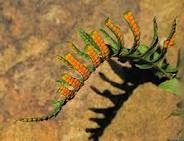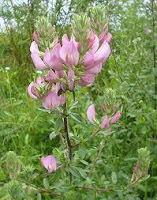 COMMON POLYPODY, POLYPODIUM VULGARE
COMMON POLYPODY, POLYPODIUM VULGARE Common Polypody is a fern of the Polypodiaceae family and is native to Britain and all other parts of Europe through to the Mediterranean region, temperate Asia and the eastern parts of North America. It is found in shady, moist places and on old walls and rocks. It grows from a creeping rhizome which has been most frequently used in traditional herbal medicine in Europe.
It is a British native fern along with
bracken,
moonwort,
hart’s tongue,
adder’s tongue and spleenwort. It was a familiar sight when I was growing up in south
Wales. The ancients believed that it grew on the roots of the European
oak, which was the Druid’s sacred tree imbued with potent power, as was
mistletoe which grew on it and also common polypody. Now we call another fern the Oak Fern,
Gymnocarpium dryopteris. However at one time this was known as the Oak Fern, Polypody of the oak, and also Wall fern, and Brake root among other names. The genus name,
Polypodium means many footed in Greek.

The rhizome is best when harvested in autumn, in October or November and used fresh or dried. The European Medicines Agency published a report on its traditional use in 2008 and as it has been safely used for more than thirty years as a mild laxative it is considered to be safe, although not recommended for use by children under twelve years old or during pregnancy or breastfeeding. It has been used for a number of purposes including for jaundice and hepatitis, indigestion and stomach upsets, to promote appetite, for respiratory problems, as a diaphoretic, diuretic and expectorant, although it should be remembered that it does have mild laxative problems. The EMA recommend that it should not be taken for longer than a week. It may cause a rash so is not recommended for external use and it can sometimes cause a rash which is not harmful when taken internally. (Assessment Report on
Polypody vulgare, L., Rhizoma EMA,
London 6th November, 2008)
 |
| spores |
Traditionally the root has been used as a poultice for rheumatic swellings, for hives, sore throats and stomach upsets. In the past a tisane or infusion was used to drive away melancholy and for scurvy (
vitamin C deficiency); when it was combined with the
common mallow or the
marsh mallow it was used for hardness of the spleen and pains in the side (stitches). It has also been used over a period of time for skin diseases.
The infusion was made with ½ ounce of the crushed roots to one pint of boiling water, left to steep for 10 minutes before straining and using in teacupfuls throughout the day as an expectorant, laxative and to promote appetite.
Honey was used to sweeten it if necessary.
The root has a sweet taste although this is quickly cloying and has been used as a
liquorice adulterant. The distilled water of the root was used for fevers as a diaphoretic, to promote sweating.
The fern fronds are mucilaginous and the mature ones, collected in autumn were boiled with coarse sugar or
gur (jaggery) and the resultant liquid was given to children with whooping-cough.
John Gerard the English herbalsit who translated the works of ancient herbalists has this to say of this fern:-
“Johannes Mesues reckoneth up Polypodie among those things that do especially dry and make thin: peradventure he had respect to a certain kind of arthritis or ache in the joints: in which not one part but many together most commonly are touched: for which it is very much commended by the Brabanders and other inhabitants about the river Rhene and the Maze. Furthermore Dioscorides saith that the root of Polypodie is very good for members out of joint and for chaps between the fingers.”
 |
| polypody spores |
A century later, Nicholas Culpeper has this to say in his “
Complete Herball”:-
“Government and virtues. It is under Jupiter in Leo. With laxatives it gently carries off the contents of the bowels without irritation. By itself it is a very mild and useful purge; but being very slow, it is generally mixed by infusion or decoction with other purging ingredients, or in broths with
beets,
parsley, ammow,
cummin,
ginger,
fennel and
annise. With mucilaginous herbs, as white beet and mallow, it is excellent in cholics. The powder taken to half a drachm daily, and fasting three hours after, is good for the spleen, jaundice, and dropsy, for it is as fine an alternative as can be procured, and will penetrate farther than most other things yet known. Some use its distilled water in a cough, asthma, diseases of the lungs, pleurisies, obstructions of the
mysentery, and in whatever cases acrimony is to be subdued. The best form to take it for any complaint of the intestines, is as follows: to an ounce of fresh polypody root bruised, add an ounce and a half of the fresh roots of white beets, and a handful of wild mallow; pour upon these a pint and a quarter of water, boiling hot, and let it stand till next day, then strain it off.” (
mesentery is a double fold on the peritoneum wall.)
 Theophrastus and Dioscorides, the ancient physicians used it and it is related that the Emperor Nero used it mixed with frankincense to heal bruises. It was used as a counter irritant to rheumatic pains, but as it causes burning and a rash along with itching, its use is not recommended. The idea was that the pain caused by its use would stop the feeling of the original pain. In much the same way the Romans are said to have used nettles to restore feeling to numbed limbs on their campaign in
Theophrastus and Dioscorides, the ancient physicians used it and it is related that the Emperor Nero used it mixed with frankincense to heal bruises. It was used as a counter irritant to rheumatic pains, but as it causes burning and a rash along with itching, its use is not recommended. The idea was that the pain caused by its use would stop the feeling of the original pain. In much the same way the Romans are said to have used nettles to restore feeling to numbed limbs on their campaign in  The root is emetic and purgative, and resin can be extracted from the root bark. It is poisonous to some animals and best not touched. A preparation of the root was used for lung problems, in folk medicine.
The root is emetic and purgative, and resin can be extracted from the root bark. It is poisonous to some animals and best not touched. A preparation of the root was used for lung problems, in folk medicine.


















